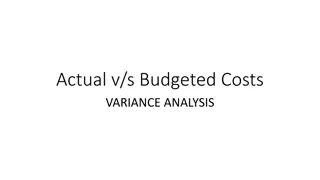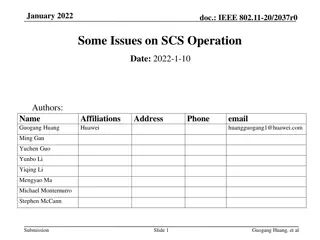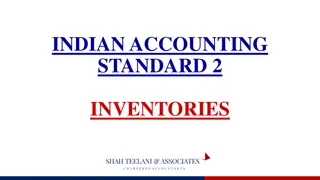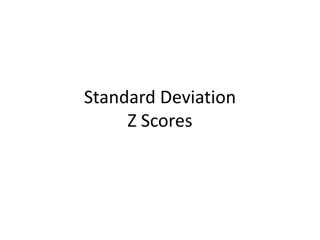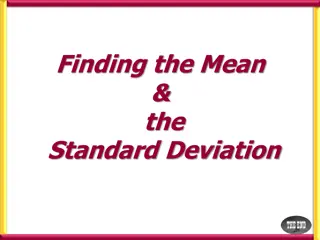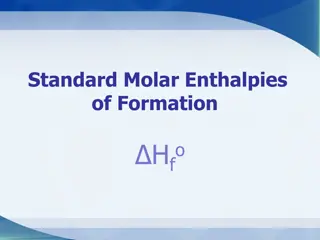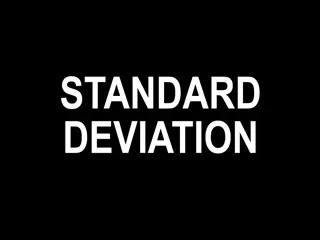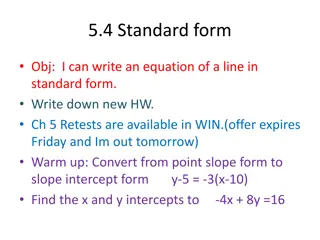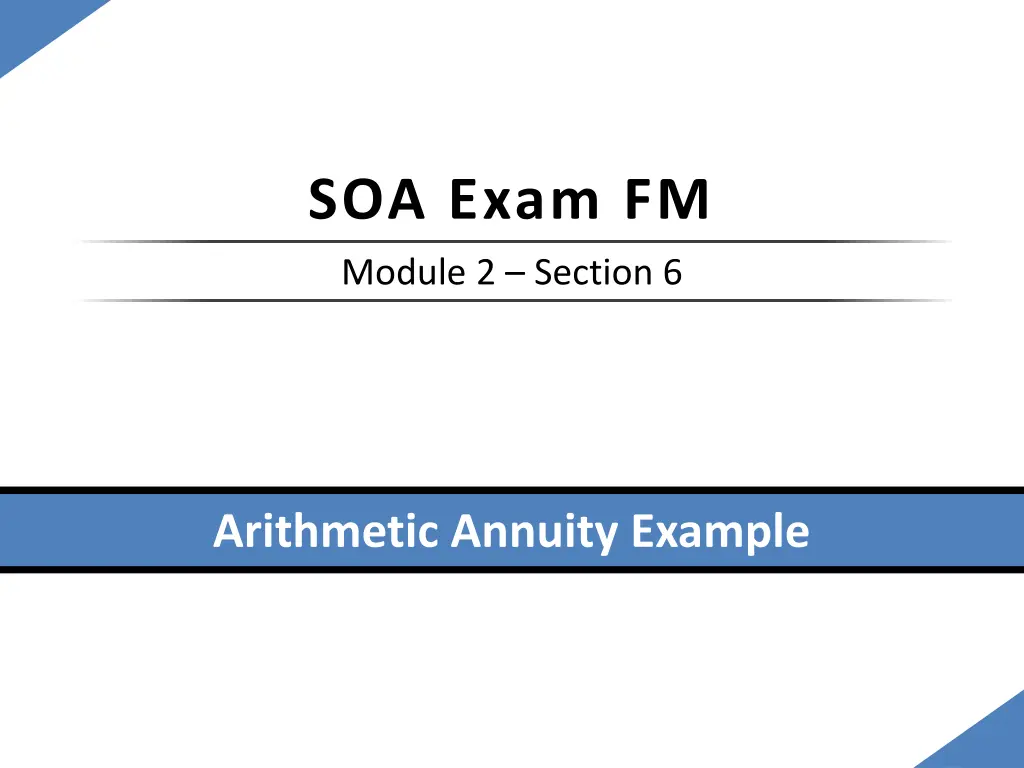
Calculating Present Value of Annuity with Increasing Payments
Learn how to determine the present value of an annuity with annual payments starting at $3 and increasing by $3 with each subsequent payment until reaching a final payment of $45, all at a 6% annual effective interest rate.
Download Presentation

Please find below an Image/Link to download the presentation.
The content on the website is provided AS IS for your information and personal use only. It may not be sold, licensed, or shared on other websites without obtaining consent from the author. If you encounter any issues during the download, it is possible that the publisher has removed the file from their server.
You are allowed to download the files provided on this website for personal or commercial use, subject to the condition that they are used lawfully. All files are the property of their respective owners.
The content on the website is provided AS IS for your information and personal use only. It may not be sold, licensed, or shared on other websites without obtaining consent from the author.
E N D
Presentation Transcript
SOA Exam FM Module 2 Section 6 Arithmetic Annuity Example
???????? ??????? An annuity due with annual payments has an initial payment of 3. Each subsequent payment is 3 more than its preceding payment until reaching a final payment of 45. Determine the present value of the annuity using a 6% annual effective interest rate.
???????? ??????? An annuity due with annual payments has an initial payment of 3. Each subsequent payment is 3 more than its preceding payment until reaching a final payment of 45. Determine the present value of the annuity using a 6% annual effective interest rate. 3 6 45
???????? ??????? An annuity due with annual payments has an initial payment of 3. Each subsequent payment is 3 more than its preceding payment until reaching a final payment of 45. Determine the present value of the annuity using a 6% annual effective interest rate. 3 6 45 ??
???????? ??????? An annuity due with annual payments has an initial payment of 3. Each subsequent payment is 3 more than its preceding payment until reaching a final payment of 45. Determine the present value of the annuity using a 6% annual effective interest rate. 3 6 45 ( = 3) ??
???????? ??????? An annuity due with annual payments has an initial payment of 3. Each subsequent payment is 3 more than its preceding payment until reaching a final payment of 45. Determine the present value of the annuity using a 6% annual effective interest rate. 45 = 3 15 3 6 45 ( = 3) ??
???????? ??????? An annuity due with annual payments has an initial payment of 3. Each subsequent payment is 3 more than its preceding payment until reaching a final payment of 45. Determine the present value of the annuity using a 6% annual effective interest rate. 3 6 45 ?? = 3(? ?)15|
???????? ??????? An annuity due with annual payments has an initial payment of 3. Each subsequent payment is 3 more than its preceding payment until reaching a final payment of 45. Determine the present value of the annuity using a 6% annual effective interest rate. 3 6 45 ?15| 15?15 ? ?? = 3(? ?)15|= 3
???????? ??????? An annuity due with annual payments has an initial payment of 3. Each subsequent payment is 3 more than its preceding payment until reaching a final payment of 45. Determine the present value of the annuity using a 6% annual effective interest rate. 3 6 45 ?15| 15?15 ? ?15| 15?15 ? ?? = 3(? ?)15|= 3 = 3 (1 + ?)
???????? ??????? An annuity due with annual payments has an initial payment of 3. Each subsequent payment is 3 more than its preceding payment until reaching a final payment of 45. Determine the present value of the annuity using a 6% annual effective interest rate. 3 6 45 ?15| 15?15 ? ?15| 15?15 ? ?? = 3(? ?)15|= 3 = 3 (1 + ?) = 3(??)15|(1 + ?)
???????? ??????? An annuity due with annual payments has an initial payment of 3. Each subsequent payment is 3 more than its preceding payment until reaching a final payment of 45. Determine the present value of the annuity using a 6% annual effective interest rate. 3 6 45 ?15| 15?15 ? ?15| 15?15 ? ?? = 3(? ?)15|= 3 = 3 (1 + ?)
???????? ??????? An annuity due with annual payments has an initial payment of 3. Each subsequent payment is 3 more than its preceding payment until reaching a final payment of 45. Determine the present value of the annuity using a 6% annual effective interest rate. 3 6 45 ?15| 15?15 ? ?15| 15?15 ? ?? = 3(? ?)15|= 3 = 3 (1 + ?) ? = ?15| 15?15
???????? ??????? An annuity due with annual payments has an initial payment of 3. Each subsequent payment is 3 more than its preceding payment until reaching a final payment of 45. Determine the present value of the annuity using a 6% annual effective interest rate. 3 6 45 ?15| 15?15 ? ?15| 15?15 ? ?? = 3(? ?)15|= 3 = 3 (1 + ?) ? ?15|+ 15?15= 0 ? = ?15| 15?15
???????? ??????? An annuity due with annual payments has an initial payment of 3. Each subsequent payment is 3 more than its preceding payment until reaching a final payment of 45. Determine the present value of the annuity using a 6% annual effective interest rate. 3 6 45 ?15| 15?15 ? ?15| 15?15 ? ?? = 3(? ?)15|= 3 = 3 (1 + ?) ? ?15|+ 15?15= 0 ? = ?15| 15?15
???????? ??????? An annuity due with annual payments has an initial payment of 3. Each subsequent payment is 3 more than its preceding payment until reaching a final payment of 45. Determine the present value of the annuity using a 6% annual effective interest rate. 3 6 45 ?15| 15?15 ? ?15| 15?15 ? ?? = 3(? ?)15|= 3 = 3 (1 + ?) ? ?15|+ 15?15= 0 ? = ?15| 15?15 TVM: ? = 15; ?/? = 6;??? = 1;
???????? ??????? An annuity due with annual payments has an initial payment of 3. Each subsequent payment is 3 more than its preceding payment until reaching a final payment of 45. Determine the present value of the annuity using a 6% annual effective interest rate. 3 6 45 ?15| 15?15 ? ?15| 15?15 ? ?? = 3(? ?)15|= 3 = 3 (1 + ?) ? ?15|+ 15?15= 0 ? = ?15| 15?15 TVM: ? = 15; ?/? = 6;??? = 1;
???????? ??????? An annuity due with annual payments has an initial payment of 3. Each subsequent payment is 3 more than its preceding payment until reaching a final payment of 45. Determine the present value of the annuity using a 6% annual effective interest rate. 3 6 45 ?15| 15?15 ? ?15| 15?15 ? ?? = 3(? ?)15|= 3 = 3 (1 + ?) ? ?15|+ 15?15= 0 ? = ?15| 15?15 TVM: ? = 15; ?/? = 6;??? = 1;?? = 15;
???????? ??????? An annuity due with annual payments has an initial payment of 3. Each subsequent payment is 3 more than its preceding payment until reaching a final payment of 45. Determine the present value of the annuity using a 6% annual effective interest rate. 3 6 45 ?15| 15?15 ? ?15| 15?15 ? ?? = 3(? ?)15|= 3 = 3 (1 + ?) ? ?15|+ 15?15= 0 ? = ?15| 15?15 TVM: ? = 15; ?/? = 6;??? = 1;?? = 15; CPT ??
???????? ??????? An annuity due with annual payments has an initial payment of 3. Each subsequent payment is 3 more than its preceding payment until reaching a final payment of 45. Determine the present value of the annuity using a 6% annual effective interest rate. 3 6 45 ?15| 15?15 ? ?15| 15?15 ? ?? = 3(? ?)15|= 3 = 3 (1 + ?) ? ?15|+ 15?15= 0 ? = ?15| 15?15 TVM: ? = 15; ?/? = 6;??? = 1;?? = 15; CPT ?? (Result = numerator)
???????? ??????? An annuity due with annual payments has an initial payment of 3. Each subsequent payment is 3 more than its preceding payment until reaching a final payment of 45. Determine the present value of the annuity using a 6% annual effective interest rate. 3 6 45 ?15| 15?15 ? ?15| 15?15 ? ?? = 3(? ?)15|= 3 = 3 (1 + ?)
???????? ??????? An annuity due with annual payments has an initial payment of 3. Each subsequent payment is 3 more than its preceding payment until reaching a final payment of 45. Determine the present value of the annuity using a 6% annual effective interest rate. 3 6 45 ?15| 15?15 ? ?15| 15?15 ? ?? = 3(? ?)15|= 3 = 3 (1 + ?) TVM:
???????? ??????? An annuity due with annual payments has an initial payment of 3. Each subsequent payment is 3 more than its preceding payment until reaching a final payment of 45. Determine the present value of the annuity using a 6% annual effective interest rate. 3 6 45 ?15| 15?15 ? ?15| 15?15 ? ?? = 3(? ?)15|= 3 = 3 (1 + ?) TVM: BGN
???????? ??????? An annuity due with annual payments has an initial payment of 3. Each subsequent payment is 3 more than its preceding payment until reaching a final payment of 45. Determine the present value of the annuity using a 6% annual effective interest rate. 3 6 45 ?15| 15?15 ? ?15| 15?15 ? ?? = 3(? ?)15|= 3 = 3 (1 + ?) TVM: 15 N BGN FV
???????? ??????? An annuity due with annual payments has an initial payment of 3. Each subsequent payment is 3 more than its preceding payment until reaching a final payment of 45. Determine the present value of the annuity using a 6% annual effective interest rate. 3 6 45 ?15| 15?15 ? ?15| 15?15 ? ?? = 3(? ?)15|= 3 = 3 (1 + ?) TVM: 15 N FV 6 I/Y BGN
???????? ??????? An annuity due with annual payments has an initial payment of 3. Each subsequent payment is 3 more than its preceding payment until reaching a final payment of 45. Determine the present value of the annuity using a 6% annual effective interest rate. 3 6 45 ?15| 15?15 ? ?15| 15?15 ? ?? = 3(? ?)15|= 3 = 3 (1 + ?) TVM: 15 N FV 6 I/Y 1 +/- PMT BGN
???????? ??????? An annuity due with annual payments has an initial payment of 3. Each subsequent payment is 3 more than its preceding payment until reaching a final payment of 45. Determine the present value of the annuity using a 6% annual effective interest rate. 3 6 45 ?15| 15?15 ? ?15| 15?15 ? ?? = 3(? ?)15|= 3 = 3 (1 + ?) PV TVM: FV 6 I/Y 1 +/- PMT CPT 15 N BGN
???????? ??????? An annuity due with annual payments has an initial payment of 3. Each subsequent payment is 3 more than its preceding payment until reaching a final payment of 45. Determine the present value of the annuity using a 6% annual effective interest rate. 3 6 45 4.0360 ?15| 15?15 ? ?15| 15?15 ? ?? = 3(? ?)15|= 3 = 3 (1 + ?) PV TVM: FV 6 I/Y 1 +/- PMT CPT 15 N BGN
???????? ??????? An annuity due with annual payments has an initial payment of 3. Each subsequent payment is 3 more than its preceding payment until reaching a final payment of 45. Determine the present value of the annuity using a 6% annual effective interest rate. 3 6 45 4.0360 ?15| 15?15 ? ?15| 15?15 ? ?? = 3(? ?)15|= 3 = 3 (1 + ?) PV TVM: FV 6 I/Y 1 +/- PMT CPT 15 N BGN .06
???????? ??????? An annuity due with annual payments has an initial payment of 3. Each subsequent payment is 3 more than its preceding payment until reaching a final payment of 45. Determine the present value of the annuity using a 6% annual effective interest rate. 3 6 45 4.0360 ?15| 15?15 ? ?15| 15?15 ? ?? = 3(? ?)15|= 3 = 3 (1 + ?) PV TVM: FV 6 I/Y 1 +/- PMT CPT 15 N BGN .06 1.06
???????? ??????? An annuity due with annual payments has an initial payment of 3. Each subsequent payment is 3 more than its preceding payment until reaching a final payment of 45. Determine the present value of the annuity using a 6% annual effective interest rate. 3 6 45 4.0360 ?15| 15?15 ? ?15| 15?15 ? ?? = 3(? ?)15|= 3 = 3 (1 + ?) PV TVM: FV 6 I/Y 1 +/- PMT CPT 15 N BGN .06 1.06 3
???????? ??????? An annuity due with annual payments has an initial payment of 3. Each subsequent payment is 3 more than its preceding payment until reaching a final payment of 45. Determine the present value of the annuity using a 6% annual effective interest rate. 3 6 45 4.0360 ?15| 15?15 ? ?15| 15?15 ? ?? = 3(? ?)15|= 3 = 3 (1 + ?) PV TVM: FV 6 I/Y 1 +/- PMT CPT 15 N BGN = .06 1.06 3
???????? ??????? An annuity due with annual payments has an initial payment of 3. Each subsequent payment is 3 more than its preceding payment until reaching a final payment of 45. Determine the present value of the annuity using a 6% annual effective interest rate. 3 6 45 4.0360 ?15| 15?15 ? ?15| 15?15 ? ?? = 3(? ?)15|= 3 = 3 (1 + ?) PV TVM: FV 6 I/Y 1 +/- PMT CPT 15 N BGN = .06 1.06 3 ?? = 213.91




